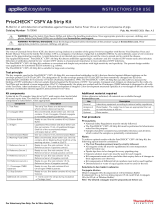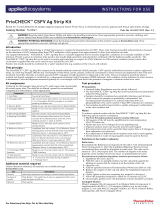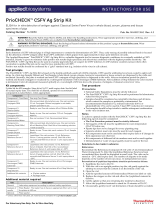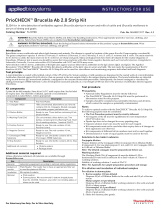Page is loading ...

INSTRUCTIONS FOR USE
For Veterinary Use Only. For In Vitro Use Only.
PrioCHECK™ Ruminant Q Fever Ab Plate Kit
Immunoenzymatic test for specific detection of anti-
Coxiella burnetii
antibodies
in ruminant serum and milk
Catalog Numbers ELISACOXLS2, ELISACOXLS5
Doc. Part No. 100020257 Pub. No. MAN0007464 Rev. B.0
Technology
Species
Sample matrix
Sample type
Protocol
Single-well indirect ELISA
-Strip plates
Bovine
Ovine
Caprine
Serum
Individual
Short incubation
Milk
Individual
Tank
Long incubation
WARNING! Read the Safety Data Sheets (SDSs) and follow the handling instructions.
Wear appropriate protective eyewear, clothing, and gloves.
Safety Data Sheets (SDSs) are available from thermofisher.com/support.
WARNING! POTENTIAL BIOHAZARD. Read the biological hazard safety information at this
product’s page at thermofisher.com. Wear appropriate protective eyewear, clothing, and gloves.
General information
The antigen (antigen phase I + II) in the Applied Biosystems™ PrioCHECK™ Ruminant Q Fever Ab Plate
Kit was isolated by the French National Institute for Agricultural Research (INRA) in Nouzilly from
domestic ruminants. This ovine strain of Coxiella burnetii is responsible for abortion in ovines.
Validations performed by INRA and in-house show that the PrioCHECK™ Ruminant Q Fever Ab Plate Kit
exhibits greater sensitivity for detecting Coxiella burnetii shedding animals than the Nine Mile ELISA kits.
Procedure overview
The test is based on the principle of an indirect ELISA assay.
1. Samples and controls are distributed in the plate coated with the Coxiella burnetii antigen. Any specific
anti-Coxiella burnetii antibodies bind to the antigen.
2. After washing, a G protein conjugate labeled with peroxidase (HRP) is added, binding to the
antibodies previously attached to the plate.
3. The unbound conjugate is eliminated by washing, followed by addition of a chromogenic substrate. A
blue color results from substrate oxidation by the HRP-conjugate.
4. After stopping the reaction, the color turns yellow. The results are read by an ELISA plate reader.
The intensity of the yellow color present in the positive samples is proportional to the amount of
specific antibodies in the sample.

2 PrioCHECK™ Ruminant Q Fever Ab Plate Kit Instructions for Use
Kit contents and storage
Component Description
ELISACOXLS2
(192 tests)
ELISACOXLS5
(480 tests)
Storage
1 - Coated microplate Q Fever
Q Fever-coated microplate, 12 strips
of 8 wells
2 units 5 units 5±3°C(1)
2a - Serum Negative C. Q Fever
Q Fever negative control (NC) serum
250 µL
600 µL
5±3°C
2b - Milk Negative C. Q Fever
Q Fever negative control (NC) milk
5 mL
12 mL
3 - Positive C. Q Fever
Q Fever positive control (PC) serum
250 µL
600 µL
4 - Conjugate (100x) Q Fever
G protein-HRP Conjugate Q Fever
(red), 100X concentrate
500 µL 900 µL 5±3°C(2)
A - Wash (10x)
Wash solution, 10X concentrate
125 mL
250 mL
5±3°C
B1 - Sample DB Q Fever
Q Fever sample dilution buffer (green)
120 mL
250 mL
B2 - Conjugate DB Q Fever
Q Fever conjugate dilution buffer
50 mL
100 mL
C - Substrate
Substrate solution
24 mL
60 mL
D - Stop
Stop solution
24 mL
60 mL
Adhesive plate covers
4
10
RT(3)
(1) Unused strips can be stored in the sealed pouch with desiccant (supplied with the kit) at 5±3°C until the kit’s expiration date.
(2) The diluted conjugate solutions should be used immediately after preparation.
(3) Room temperature
Materials required but not provided
Unless otherwise indicated, all materials are available through thermofisher.com.
Single and multi-channel micropipettes
Distilled or deionized water
Pre-dilution plates
Disposable containers
Microplate incubator (37±2°C)
ELISA reader equipped with a 450 nm filter or
450 and 620 nm filters
Disposable pipette tips
Important procedural guidelines
•Do not mix reagents from different kit batches.
•Avoid contaminating the reagents by using single-use sampling equipment.
•Do not pipette reagents by mouth.
Preparation of samples
Serum: Fresh, refrigerated serum (8 days at 5±3°C) or frozen serum (1 year at < −16°C) can be used.
The pre-homogenized samples and controls are tested at a 1:400 dilution.
Milk: Fresh, refrigerated milk (individual or tank) (8 days at 5±3°C) or frozen milk (1 year at < −16°C) can
be used with or without an added preservative.
The pre-homogenized samples and controls are tested at a 1:20 dilution.
NOTE: The use of an internal tracer is highly recommended for each test series. An internal reference
(Cat. No. RFQS) is available for serum or milk use.
Preparation of reagents
•Reagents 1 - Coated microplate Q Fever, B1 - Sample DB Q Fever, B2 - Conjugate DB Q Fever,
C Substrate and D - Stop are ready for use.
•Reagents 2a - Serum Negative C. Q Fever, 2b - Milk Negative C. Q Fever and 3 - Positive C. Q Fever
(for serum use only) are tested as samples.
•Milk Positive Control Q Fever is prepared from a 1:20 dilution of reagent 3 Positive C. Q Fever.
Example: 10 µL of reagent 3 - Positive C. Q Fever + 190 µL of reagent 2b - Milk Negative C. Q Fever.
Mix after diluting. The Milk Positive Control Q Fever solution should be used immediately after
dilution and tested as a sample.
•A - Wash (10x) solution should be diluted to 1:10 in distilled/deionized water.
Example: for one strip: 2 mL of A - Wash (10x) solution in 18 mL of water; for one plate: 25 mL of
A Wash (10x) solution in 225 mL of water.
Mix after diluting. The diluted Wash solution can be stored for 1 month at 5±3°C.
NOTE: Due to the high salt concentration, crystals may form in the A - Wash (10x) solution. Prior to
dilution, shake the bottle to dissolve any crystals.

PrioCHECK™ Ruminant Q Fever Ab Plate Kit Instructions for Use 3
•Reagent 4 - Conjugate (100x) Q Fever should be diluted to 1:100 in B2 - Conjugate DB Q Fever reagent.
Mix after diluting. Use the diluted Conjugate Q Fever solution immediately after dilution.
Perform the ELISA test
NOTE: Bring the reagents to room temperature (21±4°C) before performing the test. The tolerance range
for incubation times is ±10%. The use of disposable containers is recommended for distribution of
components.
1. Distribution of controls and samples
Serum samples and controls are tested diluted to 1:400 in B1 - Sample DB Q Fever reagent:
A. In a pre-dilution plate, pre-dilute the serum samples and controls to 1:20 in B1 - Sample DB Q Fever
reagent:
•Add 5 µL of each serum to the wells of the pre-dilution plate. Keep the same order as the one that
will be used on the coated plate.
•Add 95 µL of reagent B1 - Sample DB Q Fever to the wells containing the controls and samples.
Gently shake the plate.
•Incubate at room temperature for 5 minutes before transferring to the coated plate.
NOTE: The pre-diluted serums can be stored for 24 hours at 5±3°C.
B. To obtain the final 1:400 dilution, perform a 2nd dilution to 1:20 in B1 - Sample DB Q Fever reagent in
the coated plate:
•Add 5 µL of reagent 2a - Serum Negative C. Q Fever pre-diluted to 1:20 to wells A1 and B1
(for example).
•Add 5 µL of reagent 3 - Positive C. Q Fever pre-diluted to 1:20 to wells C1 and D1 (for example).
•Add 5 µL of serum sample pre-diluted to 1:20 to the remaining wells.
•Add 95 µL of reagent B1 - Sample DB Q Fever to each well containing the controls or samples.
Gently shake, then cover the plate with an adhesive plate cover. Incubate the plate for 1 hour
at 37±2°C.
Milk samples and controls are tested diluted to 1:20 in B1 - Sample DB Q Fever reagent:
•Add 5 µL of reagent 2b - Milk Negative C. Q Fever to wells A1 and B1 (for example).
•Add 5 µL of Milk Positive Control Q Fever solution (see “Preparation of reagents”) to wells C1 and
D1 (for example).
•Add 5 µL of milk to the remaining wells.
•Add 95 µL of reagent B1 - Sample DB Q Fever to each well containing the controls or samples.
Gently shake, then cover the plate with an adhesive plate cover. Incubate the plate overnight
(16 to 18h) at 5±3°C.
2. Washing steps (3 washes)
Empty the plate and perform 3 washes with the diluted Wash solution (see “Preparation of reagents”)
using 300 µL per well. Empty and tap the plate on absorbent paper to eliminate any traces of liquid.
Washes can be performed either manually or automated using a plate washer. Do not allow the plate to
dry out.
3. Distribution of conjugate
Add 100 µL of diluted Conjugate Q Fever solution (see “Preparation of reagents”) to each well. Gently
shake the plate, and cover the plate using a new adhesive plate cover. Incubate the plate for 1 hour
at 37±2°C.
4. Washing steps (3 washes)
Repeat the Washing steps (step 2) as described above.
5. Test development
Add 100 µL of solution C - Substrate to each well. Gently shake the plate for 2 seconds. Incubate for
10 minutes at room temperature (21±4°C) in darkness. Do not cover the plate.
Add 100 µL of solution D - Stop to each well and in the same order as solution C - Substrate. Gently
shake the plate for 2 seconds.
6. Reading
Dry the bottom of the plates with a soft tissue to remove any dust. Read the plate within 30 minutes after
stopping the reaction at 450 nm (monochromatic) or at dual wavelengths of 450−620 nm on a microplate
reader.

thermofisher.com/support | thermofisher.com/askaquestion
thermofisher.com
15 June 2016
Calculation
Calculate the average OD (Optical Density) of the
PC (ODm PC), and that of the NC (ODm NC).
For each sample, calculate the S/P
(Sample/Positive) ratio:
S/P = (OD Sample – ODm NC) / (ODm PC – ODm NC)
Titer = S/P × 100
NOTE: For negative samples, S/P ratios may be < 0.
Validation
The test is validated if:
ODm PC > 0.400 and ODm PC / ODm NC > 2
Interpretation of results
Table 1 Serum
Results
Interpretation
Titer ≤ 40
Negative
40 < Titer ≤ 100
Positive +
100 < Titer ≤ 200
Positive ++
200 < Titer ≤ 300
Positive +++
Titer > 300
Positive ++++
Table 2 Individual milk
Results
Interpretation
Titer ≤ 40
Negative
40 < Titer ≤ 100
Positive +
100 < Titer ≤ 200
Positive ++
Titer > 200
Positive +++
Table 3 Tank milk
Results
Interpretation
Titer ≤ 30
Negative
30 < Titer ≤ 100
Positive +
100 < Titer ≤ 200
Positive ++
Titer > 200
Positive +++
Documentation and support
Customer and technical support
Technical support: visit
thermofisher.com/askaquestion
Visit thermofisher.com/support for the latest in
services and support, including:
•Worldwide contact telephone numbers
•Order and web support
•User guides, manuals, and protocols
•Certificates of Analysis
•Safety Data Sheets (SDSs; also known as MSDSs)
NOTE: For SDSs for reagents and chemicals from
other manufacturers, contact the manufacturer.
Limited product warranty
Life Technologies Corporation and/or its
affiliate(s) warrant their products as set forth in the
Life Technologies' General Terms and Conditions
of Sale found on Life Technologies' website at
www.thermofisher.com/us/en/home/global/
terms-and-conditions.html. If you have any
questions, please contact Life Technologies at
thermofisher.com/support.
Prionics Lelystad B.V. | Platinastraat 33 |
8211 AR Lelystad | The Netherlands
Translated from the French Pub. No. MAN0007465 Rev. A.0.
The information in this guide is subject to change without notice.
DISCLAIMER: TO THE EXTENT ALLOWED BY LAW, LIFE
TECHNOLOGIES AND/OR ITS AFFILIATE(S) WILL NOT BE LIABLE
FOR SPECIAL, INCIDENTAL, INDIRECT, PUNITIVE, MULTIPLE, OR
CONSEQUENTIAL DAMAGES IN CONNECTION WITH OR ARISING
FROM THIS DOCUMENT, INCLUDING YOUR USE OF IT.
Revision history: Pub. No. MAN0007464 (English)
Rev.
Date
Description
B.0 15 June
2016
Updated to the current document template,
with associated updates to the warranty,
trademarks, and logos.
A.0 January
2014
• Corrected number of washes in steps 2 and 4.
•
Changed dilution ratio from fraction style to
colon style.
• Added revision history table.
1.0
May 2013
Life Technologies format document.
Limited Use Label License No. 473: Veterinary Diagnostic Assay.
The purchase of this product conveys to the purchaser the limited,
non-transferable right to use the purchased amount of the product
only to perform veterinary diagnostic services including reporting
the results of such services for a fee, and internal research for the
sole benefit of the purchaser. No right to resell, repackage, or dis-
tribute this product, or any of its components, is conveyed express-
ly, by implication, or by estoppel. For information on obtaining
additional rights, please contact outlicensing@lifetech.com or
Out Licensing, Life Technologies, 5791 Van Allen Way, Carlsbad,
California 92008.
©2016 Thermo Fisher Scientific Inc. All rights reserved. All
trademarks are the property of Thermo Fisher Scientific and its
subsidiaries unless otherwise specified.
/









